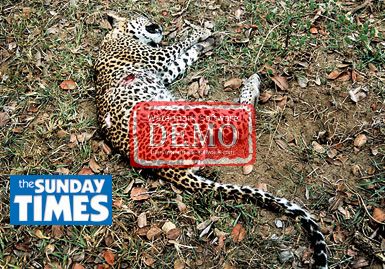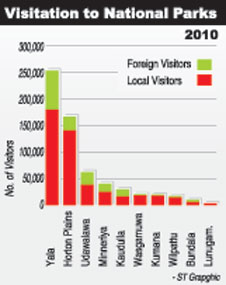Visitors to wildlife parks have a responsibility to protect the wildlife they are so eager to see. Excessive eagerness, compounded with callous disregard for basic road safety rules and consideration for others, can result in the kind of hit and run tragedy that occurred recently when a speeding vehicle killed a leopard within the Yala wildlife sanctuary. Images of the roadkill shocked and enraged the public, and animal lovers in particular.
The latest enemy to invade protected wildlife terrain is the mobile phone - a piece of technology visitors are increasingly using to alert other visitors when they have sighted a rare animal, usually a leopard.
Whenever a leopard is seen, mobile phones are plucked out and messages sent, and minutes or seconds later, convoys of speeding safari trucks and cars rush to the scene - a spectacle that belongs to crowded urban areas, not to a wildlife sanctuary.
 |
| The leopard that was found dead in Yala recently.
Pic by Spencer Manuelpillai |
Irresponsible vehicle owners who disturb animals and threaten their existence is a growing problem, and one that is tarnishing the genuine wildlife experience, animal lovers say.
On a "good day," hundreds of vehicles can be seen heading into Yala, and they usually keep to routes known for leopard sightings. The instant a leopard is seen, mobile phones are plucked out, messages are conveyed, and the race is on.
Animal lovers are calling for a total ban on mobile phones within wildlife premises, or at least an order prohibiting mobile phone use by visitors. Activists have also called for the shutting off of mobile phone transmission towers in the neighbourhood of a sanctuary. They suggest that the transmission towers be switched off during sight-seeing peak hours, from 6:00 am to 9:00 am and from 3:00 pm - 6:00 pm.
Vimukthi Weeratunge of Environmental Foundation Limited (EFL) is on the team that is working on an action plan for Yala.
He said even trackers were calling for regulation of the Yala transmission tower. Mobile phone operators have no problem with switching off transmission towers at designated times, he said, as long as the Telecommunication Regulation Commission (TRC) gives its approval. It is up to the Department of Wildlife Conservation (DWC) and Sri Lanka Tourism to follow up and see the matter through.
Vipula Wanigasekera, acting director-general of Sri Lanka Tourism, told the Sunday Times that mobile phone connectivity was vital inside a wildlife reserve in case of emergencies, and that awareness-raising and the promotion of proper "road" behaviour, was the answer.
Meanwhile, no action has so far been taken regarding the hit-and-run killing of the Yala leopard.
Tharindu Jayasinghe, secretary of the Yala Jeep Drivers' Association, said it was unlikely that a driver of a safari vehicle registered with the organisation, was responsible. He believed the death was likely caused by visitors who had booked a Yala bungalow or set up camp inside the game reserve.
Others interviewed by the newspaper said the death could have been caused by vehicles arriving early that morning from Yala Block II. |



